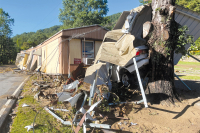Must have been an omen
When I checked my email Friday morning (9/9), I had a message from Chris Kelly, mountain wildlife diversity biologist with North Carolina Natural Resources Commission. Kelly helps coordinate an annual nightjar (birds of the family Caprimulgidae like Chuck-will’s-widow and whip-poor-will) survey across the mountains of North Carolina for the national Nightjar Survey Network. The email was an update for those who volunteer for the nightjar survey but it started out with a note that, “It is Common Nighthawk migration time!”
Can’t see the forest for the webs
From what I gather from Facebook and overhear in the checkout line, the view I encounter every morning on my daily trip from Balsam Gap to Tuscola High School is pretty much standard across Western North Carolina and, according to a Google search across much of the country – places like Michigan, Pennsylvania, Maryland, Missouri, and others. That view is one of roadside trees full of what looks like dirty gray-brown plastic bags.
Ma Nature doesn’t see things the way we do
The red-cockaded woodpecker (RCWO) is a small – cardinal-sized – woodpecker native to eastern pine forests. It once ranged from New Jersey southward to Florida and westward to eastern Texas and portions of Oklahoma and Missouri. The RCWO is dependant upon old growth pine forests, especially longleaf pine.
A real can of DNA worms
A new whole-genome (the entire genetic makeup) study published in Science Advances on July 27 is giving the already muddied waters of wolf-coyote ancestry another stir.
Wading through nostalgia
 Give a Loosiana boy a reason to don his hip boots and strap on a headlight and you’ve got a happy camper. I recently got that opportunity through a contract with the Forest Service to do a salamander survey on three streams in the Cheoah District of the Nantahala National Forest. The three small headwater streams were Wolf Laurel, Sand Creek and Whiggs Branch.
Give a Loosiana boy a reason to don his hip boots and strap on a headlight and you’ve got a happy camper. I recently got that opportunity through a contract with the Forest Service to do a salamander survey on three streams in the Cheoah District of the Nantahala National Forest. The three small headwater streams were Wolf Laurel, Sand Creek and Whiggs Branch.
Combination science lab and amusement park
 Weightless for two seconds is not a moonwalk but at the top of the Space Shot at Huntsville, Alabama’s (Rocket City) U.S. Space & Rocket Center, it does give your brain a split second to wonder — am I going up or down?
Weightless for two seconds is not a moonwalk but at the top of the Space Shot at Huntsville, Alabama’s (Rocket City) U.S. Space & Rocket Center, it does give your brain a split second to wonder — am I going up or down?
Peregrines once again at Devil’s Courthouse
 A couple of Saturday’s ago Bob Olthoff and I made a quick trip up the Blue Ridge Parkway. We were going up to Black Balsam to look for yellow-rumped warblers. Yellow-rumps are regular visitors to Western North Carolina during the winter but generally pack their bags and head back to New England and/or Canada for nesting season. Occasionally nesting yellow-rumps can be found at higher elevations in the mountains of North Carolina.
A couple of Saturday’s ago Bob Olthoff and I made a quick trip up the Blue Ridge Parkway. We were going up to Black Balsam to look for yellow-rumped warblers. Yellow-rumps are regular visitors to Western North Carolina during the winter but generally pack their bags and head back to New England and/or Canada for nesting season. Occasionally nesting yellow-rumps can be found at higher elevations in the mountains of North Carolina.
Keep your salamander away from my newt
 I often remind everyone who reads “The Naturalist’s Corner” to remember to look up. But each spring while surveying birds for the Forest Service I am reminded to look down. I have a couple of survey points in the Pisgah National Forest along Locust Creek near the South Toe River that must be red eft mecca. Red eft is the terrestrial stage of eastern or red-spotted newt (Notophthalmus viridescens.)
I often remind everyone who reads “The Naturalist’s Corner” to remember to look up. But each spring while surveying birds for the Forest Service I am reminded to look down. I have a couple of survey points in the Pisgah National Forest along Locust Creek near the South Toe River that must be red eft mecca. Red eft is the terrestrial stage of eastern or red-spotted newt (Notophthalmus viridescens.)
Canucks amongst us
 You’re hiking streamside through a rhododendron tangle when you hear a short, musical trill – it kind of mimics the riffles in the stream. I know, you’re in a hurry – got a lot of hiking to do. But if you have a minute to track this little chorister down you won’t be disappointed. What you’re hearing is a Canada warbler.
You’re hiking streamside through a rhododendron tangle when you hear a short, musical trill – it kind of mimics the riffles in the stream. I know, you’re in a hurry – got a lot of hiking to do. But if you have a minute to track this little chorister down you won’t be disappointed. What you’re hearing is a Canada warbler.
Evolution
 I spend six weeks every spring doing bird surveys for the Forest Service across Western North Carolina. My travels take me from Hiwassee Dam, to Lake Chatuge, to Black Balsam, to Hot Springs, to the Pinks Beds, to Roan Mountain, Mount Mitchell, Roaring Creek and Boone Fork plus other locations.
I spend six weeks every spring doing bird surveys for the Forest Service across Western North Carolina. My travels take me from Hiwassee Dam, to Lake Chatuge, to Black Balsam, to Hot Springs, to the Pinks Beds, to Roan Mountain, Mount Mitchell, Roaring Creek and Boone Fork plus other locations.





